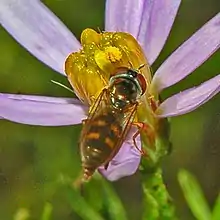| Platycheirus scutatus | |
|---|---|
 | |
| Female of Platycheirus scutatus | |
| Scientific classification | |
| Kingdom: | |
| Phylum: | |
| Class: | |
| Order: | |
| Family: | |
| Subfamily: | |
| Tribe: | |
| Genus: | |
| Subgenus: | Platycheirus |
| Species: | P. scutatus |
| Binomial name | |
| Platycheirus scutatus (Meigen, 1822) | |
| Synonyms | |
| |
Platycheirus scutatus is a very common species of hoverfly. It is a Holarctic species.[1][2]
Description
External images
For terms, see: Morphology of Diptera.
Face has two large, silver-grey dust spots. Wing: Tibia 2 is in-bent 1/3 from apex and with only short lateral hairs. Tergite 4 is elongate.
Distribution
Palearctic: Fennoscandia south to Iberia and the Mediterranean basin from Ireland eastward through Northern Europe, Central Europe and Southern Europe into Turkey and European Russia and through Siberia to the Pacific coast and Japan. Nearctic: Alaska south to Colorado. But see Speight (2011).[8] [9][10][11]
Biology
The larvae feed on aphids on low-growing plants and trees. Adults feed on a wide range of flowers. They have multiple broods throughout the warmer months and have a very long flight period.[2] They may stay active during cold weather.[12]
References
- ↑ Ball, Stuart; Morris, Roger (2013). Britain's Hoverflies: An Introduction to the Hoverflies of Britain. Woodstock, Oxfordshire: Princeton University Press. pp. 296pp. ISBN 978-0-691-15659-0.
- 1 2 Stubbs, Alan E.; Falk, Steven J (1983). British Hoverflies: An Illustrated Identification Guide (2nd ed.). London: British Entomological and Natural History Society. pp. 253, xvpp. ISBN 1-899935-03-7.
- ↑ Van Veen, M. (2004). Hoverflies of Northwest Europe: identification keys to the Syrphidae. 256pp. KNNV Publishing, Utrecht.addendum.
- ↑ Van der Goot, V.S. (1981). De zweefvliegen van Noordwest - Europa en Europees Rusland, in het bijzonder van de Benelux. KNNV, Uitgave no. 32: 275pp. Amsterdam.
- ↑ Bei-Bienko, G.Y. & Steyskal, G.C. (1988). Keys to the Insects of the European Part of the USSR, Volume V: Diptera and Siphonaptera, Part I. Amerind Publishing Co., New Delhi. ISBN 81-205-0080-6.
- ↑ Coe, R.L. (1953). "Diptera: Syrphidae". Handbks. Ident. Br. Insects 10(1): 1-98. R. Ent. Soc. London. pdf.
- ↑ Ohara, Kenji (1980). "he genus Platycheirus Lepeletier and Serville, 1818 (Diptera, Syrphidae) of Japan, with description of three new species" (PDF). Esakia. 15: 97–142.
- ↑ Speight, M.C.D. (2011). "Species accounts of European Syrphidae (Diptera)" (PDF). Syrph the Net, the database of European Syrphidae. 65: 285pp.
- ↑ Fauna Europaea.
- ↑ Peck, L.V. (1988). "Syrphidae". In: Soos, A. & Papp, L. (eds.). Catalogue of Palaearctic Diptera 8: 11-230. Akad. Kiado, Budapest.
- ↑ Vockeroth, J.R. (1992). The Flower Flies of the Subfamily Syrphinae of Canada, Alaska, and Greenland (Diptera: Syrphidae). Part 18. The Insects and Arachnids of Canada. Ottawa, Ontario: Canadian Government Pub Centre. pp. 1–456. ISBN 0-660-13830-1.
- ↑ Bug Guide